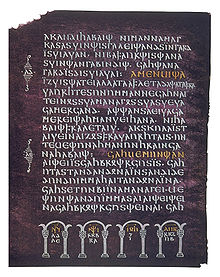



Purple parchmentorpurple vellum refers to parchment dyed purple; codex purpureus refers to manuscripts written entirely or mostly on such parchment. The lettering may be in gold or silver. Later[when?] the practice was revived for some especially grand illuminated manuscripts produced for the emperors in Carolingian art and Ottonian art, in Anglo-Saxon England and elsewhere. Some just use purple parchment for sections of the work; the 8th-century Anglo-Saxon Stockholm Codex Aureus alternates dyed and un-dyed pages.
It was at one point supposedly restricted for the use of Roman or Byzantine emperors, although in a letter of Saint Jerome of 384, he "writes scornfully of the wealthy Christian women whose books are written in gold on purple vellum, and clothed with gems".[1]
The Purple Uncials or the Purple Codices is a well-known group of these manuscripts, all 6th-century New Testament Greek manuscripts:
Two other purple New Testament Greek manuscripts are minuscules:
There is a 9th-century lectionary:
Another six New Testament purple manuscripts are in Latin (with corresponding sigla a, b, e, f, i, j). Besides some scattered fragments, they are held mainly in: Brescia, Naples, Sarezzano, Trent and Vienna. Three of these use Vetus Latina texts:
There is also one Gothic purple codex – the Codex Argenteus (illuminated).
There is a purple manuscript of part of the Septuagint:
Other illuminated manuscripts include the Godescalc Evangelistary of 781–3, the Vienna Coronation Gospels (early 9th century) and a few pages of the 9th-century La Cava Bible from the Kingdom of Asturias. Anglo-Saxon examples include a lost 7th-century Gospels commissioned by Saint Wilfrid.
This article about a book related to Christianity is a stub. You can help Wikipedia by expanding it. |